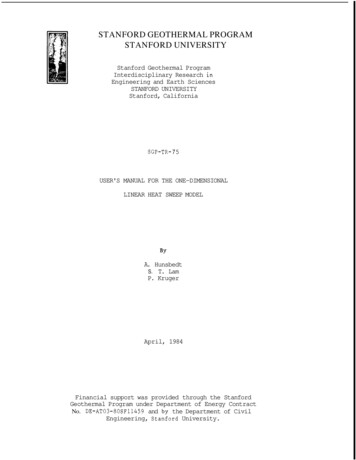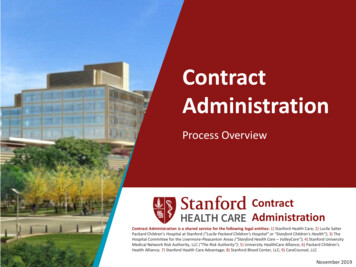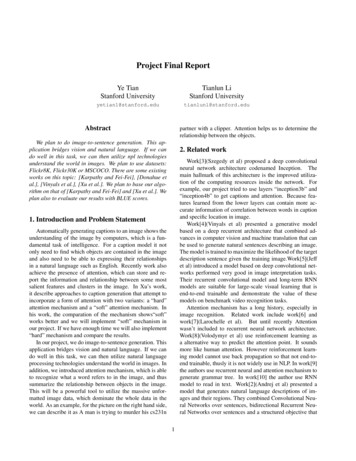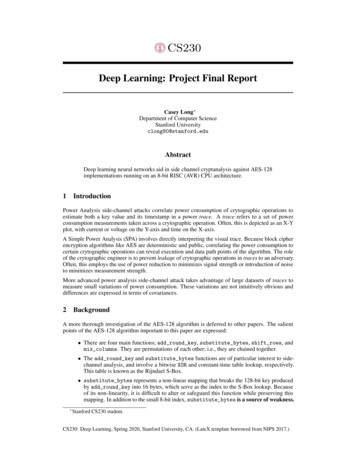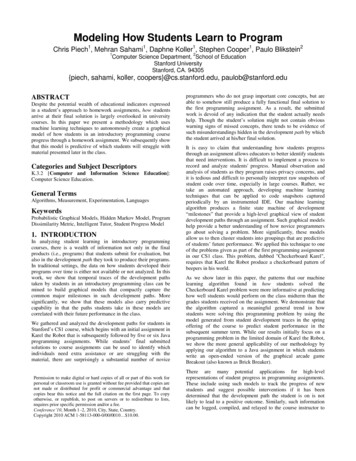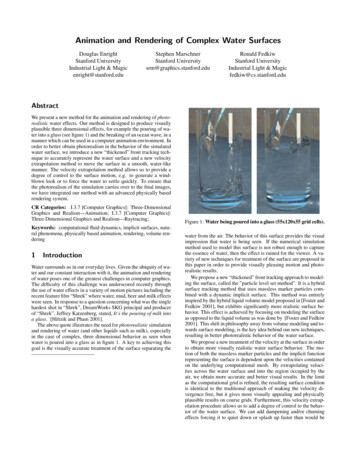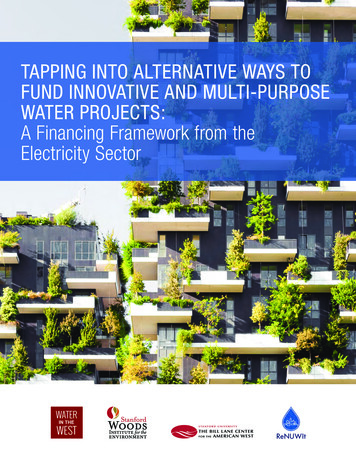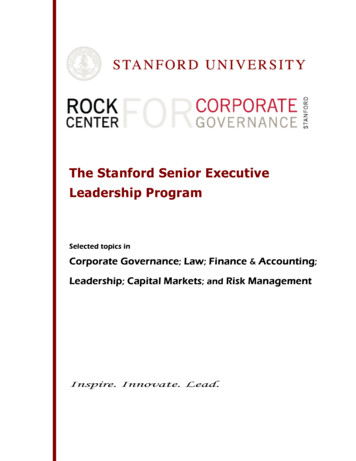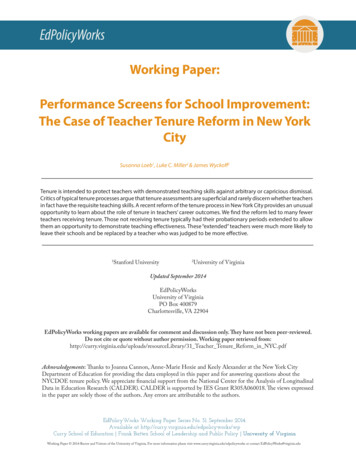
Transcription
EdPolicyWorksWorking Paper:Performance Screens for School Improvement:The Case of Teacher Tenure Reform in New YorkCitySusanna Loeb1, Luke C. Miller2 & James Wyckoff2Tenure is intended to protect teachers with demonstrated teaching skills against arbitrary or capricious dismissal.Critics of typical tenure processes argue that tenure assessments are superficial and rarely discern whether teachersin fact have the requisite teaching skills. A recent reform of the tenure process in New York City provides an unusualopportunity to learn about the role of tenure in teachers’ career outcomes. We find the reform led to many fewerteachers receiving tenure. Those not receiving tenure typically had their probationary periods extended to allowthem an opportunity to demonstrate teaching effectiveness. These “extended” teachers were much more likely toleave their schools and be replaced by a teacher who was judged to be more effective.1Stanford UniversityUniversity of Virginia2Updated September 2014EdPolicyWorksUniversity of VirginiaPO Box 400879Charlottesville, VA 22904EdPolicyWorks working papers are available for comment and discussion only. They have not been peer-reviewed.Do not cite or quote without author permission. Working paper retrieved rary/31 Teacher Tenure Reform in NYC.pdfAcknowledgements: Thanks to Joanna Cannon, Anne-Marie Hoxie and Keely Alexander at the New York CityDepartment of Education for providing the data employed in this paper and for answering questions about theNYCDOE tenure policy. We appreciate financial support from the National Center for the Analysis of LongitudinalData in Education Research (CALDER). CALDER is supported by IES Grant R305A060018. The views expressedin the paper are solely those of the authors. Any errors are attributable to the authors.EdPolicyWorks Working Paper Series No. 31. September 2014.Available at http://curry.virginia.edu/edpolicyworks/wpCurry School of Education Frank Batten School of Leadership and Public Policy University of VirginiaWorking Paper 2014 Rector and Visitors of the University of Virginia. For more information please visit www.curry.virginia.edu/edpolicyworks or contact EdPolicyWorks@virginia.edu
Teacher Tenure Reform in NYCPERFORMANCE SCREENS FOR SCHOOL IMPROVEMENT:THE CASE OF TEACHER TENURE REFORM IN NEW YORK CITYSusanna Loeb, Luke C. Miller & James WyckoffIntroductionTeacher tenure has been controversial since the first tenure provisions were enacted over acentury ago. Proponents typically argue that tenure prevents teacher dismissal for political purposesor due to capricious decisions by administrators or politicians. Tenure could guard against dismissalof more experienced, higher paid teachers during periods of tight budgets when school leaders maybe more focused on reducing costs while meeting class size requirements than they are on studentlearning. Tenure does not require schools or districts to retain ineffective teachers but insteadprovides a due process mechanism to dismiss tenured teachers for cause. Critics, however, arguethat the cost of due process does, in practice, lead districts to retain ineffective teachers and as aresult tenure not only allows poor teachers to stay in the classroom but also reduces the incentive forteachers to be as effective as they could be. They argue that the due process mechanisms forremoving teachers with tenure are so burdensome that they rarely are pursued.With the availability of large-scale student performance measures linked over time has comeclear evidence that teachers vary substantially in their effectiveness at improving student testperformance and that these differences can have meaningful effects on students in both the shortrun and the long run (Chetty, Friedman, & Rockoff, 2012; Rivkin, Hanushek and Kain, 2005;Rockoff, 2004). At least partially as a result, education reforms in the US recently are focusing onimproving the quality of teaching through human resource policies such as improved evaluationsystems and differentiated pay. Given the controversial nature of teacher tenure, it is not surprisingthat interest also has increased in changing teacher tenure provisions so that the due process is lessonerous and so that school leaders have greater control over their workforce. Yet, the evidence onwhich to base reform decisions is scarce. We know little about what types of tenure provisionsimprove the quality of teaching and what types do not. Similarly, we know little about how long theprobationary period prior to tenure should be, if there is tenure, in order for school systems toaccurately assess teachers’ effectiveness so that they can make well informed decisions about tenure.Part of the reason that we have little evidence on the effects of tenure is that until recentlytenure laws have been relatively stable over time and similar, though not the same, across states.EdPolicy W orks W orking Pa per Series N o. 31. September 20 14.Availa ble at http:/ / curry .virginia .edu/ edpolicy w orks/ w pCurry School of Educa tion Frank Batten School of Lea dership a nd Public Policy University of Virginia1
Teacher Tenure Reform in NYCNew Jersey passed the nation’s first teacher tenure law in 1909. Over the next several decades otherstates adopted similar laws: New York in 1917, California in 1921, and Michigan, Pennsylvania, andWisconsin in 1937. The state statutes used a variety of synonyms for tenure: continuing contract orservice, permanent status, career status, and post-probationary status. Regardless of the terminology,these laws have three main components: tenure requirements, reasons for dismissal, and process forappeals. The first specifies the length of the probationary period after which teachers are eligible fortenure. Employers can dismiss a non-tenured teacher at any time for any reason so long as thedecision is neither arbitrary or capricious nor discriminatory, but tenured teachers can only bedismissed for the reasons provided in the law. The third component details the appeals process adismissed tenure teacher can pursue in an effort to be reinstated. Of the 48 states in which publicelementary and secondary teachers are awarded tenure, the minimum probationary period exceedsthree years in 11 states (National Council on Teacher Quality, 2012). In most states it is three years,although in a few states, such as California, teachers typically receive tenure with fewer than threeyears of experience.The last decade has seen substantial change in tenure laws in the US. In 2000, Georgiaeliminated due process rights for teachers hired after 1 July 2000, but reinstated these rights threeyears later. Florida eliminated teacher tenure in 2011. That same year Idaho enacted a law that wouldhave eliminated teacher tenure had it not been repealed by voters the following year. Voters in SouthDakota turned back an effort to repeal a 2012 law thereby allowing a law eliminating tenure after 1July 2016 to take effect. North Carolina’s governor signed a bill into law last year that eliminatesteacher tenure by 2018. Most recently, the court ruling in the Vergara case has set California on asimilar course pending any appeal. Though almost all states currently grant tenure, more than halfnow require meaningful evaluation during the tenure process. As an example, in 2009 only fourstates used student test performance as a criterion for tenure; by 2012, 20 states did and 25 statesrequire multiple categories for teachers in their evaluation, not just satisfactory and unsatisfactory(National Council on Teacher Quality, 2012).A recent reform by the NYCDOE provides an unusual opportunity to learn about the roleof tenure in teachers’ career outcomes including both strategic retention on the district side andchoice-based retention stemming from teachers’ decisions. In what follows, we start by describingthe reform. We then use data from NYCDOE and the New York State Education Department(NYSED) to provide initial evidence on the magnitude of responses to the reform, concluding withEdPolicy W orks W orking Pa per Series N o. 31. September 20 14.Availa ble at http:/ / curry .virginia .edu/ edpolicy w orks/ w pCurry School of Educa tion Frank Batten School of Lea dership a nd Public Policy University of Virginia2
Teacher Tenure Reform in NYCa discussion of the results. We find that the NYCDOE tenure reforms extended the probationaryperiods of teachers judged to be less effective and that these “extended” teachers were substantiallymore likely than other teachers to leave their schools. Their likely replacements were typically moreeffective as judged by their principals and as measured by value-added. These changesdisproportionately benefited schools with larger percentages of black students.The Teacher Tenure Process in New York CityThe criterion for tenure in New York City is that a teacher possesses “significantprofessional skill and a meaningful, positive impact on student learning.” This criterion is not new.However, prior to AY 2009-10 the tenure process in New York City was similar to that in manyother large urban districts. The receipt of tenure had become an expectation for nearly all teachersand frequently was based on little evidence of accomplishment. In 2007-08 and 2008-09, well intothe period of accountability reforms, 94 percent of all eligible teachers were approved for tenure.Beginning in 2009-10, New York City changed the tenure review process, infusing moreinformation and increasing the responsibility and accountability of principals to insure that teachersmet challenging performance standards. Tenure decisions in 2009-10 were informed by sources ofinformation that had been available previously: classroom observations, evaluations of teacher workproducts including lesson plans, and the annual rating sheet that principals completed givingteachers a Satisfactory, Doubtful, or Unsatisfactory rating. In addition, tenure decisions in 2009-10included new student learning measures from the Teacher Data Reports (which included teachervalue-added), in-class assessments aligned with the New York State standards, and other evidence ofstudent progress (NYCDOE, 2009).As in previous years, principals sent recommendations to the superintendent about whethera teacher should be denied tenure, have their probationary period extended or be granted tenure, butstarting in 2009-10 principals had to provide a rationale for this decision if the evidence available atthe district level suggested either a strong case to approve or deny tenure and this information rancounter to the principal’s recommendation. The district provided principals with tenure guidance forteachers for whom there was evidence that performance was particularly strong or weak. For ateacher whose value-added results had been in the lowest 50 percent over the past two years (with a95 percent confidence interval), who had previously received an Unsatisfactory annual rating, orwhose tenure decision had previously been extended, the principal received guidance from theEdPolicy W orks W orking Pa per Series N o. 31. September 20 14.Availa ble at http:/ / curry .virginia .edu/ edpolicy w orks/ w pCurry School of Educa tion Frank Batten School of Lea dership a nd Public Policy University of Virginia3
Teacher Tenure Reform in NYCdistrict that the teacher should be considered to have “tenure in doubt”. A principalrecommendation to extend or approve tenure for these teachers required a supporting rationale forthe superintendent to consider in his or her review. The principal received guidance of “tenurelikely” for a teacher whose value-added results had been in the highest 50 percent over the past twoyears (with a 95 percent confidence interval). Principals recommending denying tenure or extendingthe probationary period for these teachers similarly needed to provide supporting evidence to thesuperintendent (NYCDOE, 2009).The process introduced in 2009-10 remained in place in 2010-11 with some notable changes(NYCDOE, 2010). New in 2010-11, principals were asked to evaluate all teachers up for a tenuredecision based a four-point effectiveness rating scale (Highly Effective, Effective, Developing andIneffective) as described in the district-developed Effectiveness Framework. 1 As in the prior year,the evidence for these ratings came from measures of the teacher’s impact on student learning suchas value-added measures from the Teacher Data Reports, student work products and tests aligned tothe New York State standards. Principals also could use evidence from measures of instructionalpractice coming from their own classroom observations, teacher work products, and the annualrating sheet that principals complete for each teacher. 2 In addition to these sources of information,which were available in the prior year as well, principals in 2010-11 gained information aboutprofessional contributions from surveys of students and parents, from measures of attendance, fromcolleague feedback, and from work products related to the Comprehensive Educational Plan foreach school. In contrast to 2009-10, principals in 2010-11 no longer received “tenure likely” or“tenure in doubt” guidance from the district but rather were given flags indicating a “low value add”teacher as an “Area of Concern” and a “high value add” teacher as a “Notable Performance”. Lowand high value-added scores were defined as in the previous year. Other problematic teacherbehaviors flagged as Areas of Concern included: low attendance (defined as exceeding 20 days in theprevious two fiscal years), an Unsatisfactory or Doubtful rating on a prior Annual Review Sheet,having been previously extended, having been previously excessed or currently in the AbsentTeacher Reserve pool.These effectiveness ratings are distinct from the ratings built into the new statewide teacher evaluation system whichwas not implemented until 3 years later in 2013-14. Although they use the same ratings scale, both the evidencesynthesized and the relative weight assigned to the evidence differs between the two.1These sources of evidence were employed in 2009-10 tenure decisions but they were not aggregated in the effectivenessratings.2EdPolicy W orks W orking Pa per Series N o. 31. September 20 14.Availa ble at http:/ / curry .virginia .edu/ edpolicy w orks/ w pCurry School of Educa tion Frank Batten School of Lea dership a nd Public Policy University of Virginia4
Teacher Tenure Reform in NYCThe tenure review process for 2011-12 was very similar to that in 2010-11, but with twoimportant changes. As before, teachers were evaluated on their impact on student learning,instructional practice and professional contributions. Principals were provided guidance as to theexpected (though not required) alignment between the effectiveness ratings they determined usingthe Effectiveness Framework and their tenure recommendations: Highly Effective and Effectiveratings were evidence in favor of granting tenure; a Developing rating, evidence for an extension;and an Ineffective rating, evidence for denying tenure. Additionally, responsibility for producingteacher value-added estimates shifted from the district to the NYSED beginning with 2010-11 andno measures were available for principals to incorporate them into their 2011-12 tenure decisions(NYCDOE, 2011).The state-provided value-added estimates did inform principals’ 2012-13 recommendations.Teachers received a growth score (0-20) that corresponded to a HEDI rating (Highly Effective,Effective, Developing, and Ineffective). No explicit guidance was provided to principals as to howto incorporate these growth ratings into their tenure recommendations. They were only told theseratings are a source of evidence for a teacher’s impact on student learning.Screening Employees to Improve QualityHow might we expect principals and teachers to respond to the New York City tenure policychanges? Consider a principal who aims to improve the quality of instruction in her school in theshort run. Principals are likely to have this goal for numerous reasons, including the high rate ofprincipal mobility in urban school districts (Beteille, Kalogrides, and Loeb, 2012), the substantialaccountability pressure on principals, and the principal training and selection mechanisms in place inNYC. 3 To be more specific, we assume that quality of instruction, 𝑌𝑠𝑡 , in school s, in time t, is afunction of the underlying quality of the teachers, 𝑇𝑠𝑡 , of some form of investment, 𝐼𝑠𝑡 , that teachersmake to improve their performance and the performance of their peers, as well as other aspects ofthe school, 𝑂𝑠𝑡 .𝑌𝑠𝑡 𝑞 𝑇𝑠𝑡 , 𝐼𝑠𝑡 , 𝑂𝑠𝑡 See Corcoran, Schwartz and Weinstein (2009) as well as descriptions of accountability in NYC untability/default.htm3EdPolicy W orks W orking Pa per Series N o. 31. September 20 14.Availa ble at http:/ / curry .virginia .edu/ edpolicy w orks/ w pCurry School of Educa tion Frank Batten School of Lea dership a nd Public Policy University of Virginia5
Teacher Tenure Reform in NYCA principal will choose to deny, extend, or grant tenure to teachers in order to maximizeschool quality. However, a priori it is not clear how their choice of tenure for a given teacher willaffect who teaches in the school, nor how it will affect teachers’ investment in their work. Thesedynamics depend upon how teachers respond to the decisions both about themselves and aboutother teachers in the school. If teachers do not change their choices in response to tenure decisionsthen the principal’s decision is straightforward – deny teachers whom they want to leave the schooland extend all other teachers. There would be no reason to recommend tenure for any teacher sincethis decision limits the principal’s future actions and provides no benefits in the present.However, there are reasons to believe that teachers do care about tenure. As an example,Brunner and Imazeki (2010) find that districts with longer probationary periods compensate teachersmore, other things equal, indicating that teachers value shorter probationary periods and are willingto accept somewhat reduced compensation in return. This finding is consistent with evidence fromother occupations that jobs with greater risk – greater physical risk, or greater risk of unemployment,or less predictable salaries – have to pay more in order to attract the same quality workers (Feinberg,1981). These results lead us to assume that in deciding whether or not to stay in a job, teachers valuejob stability and thus care about whether or not they have tenure.Teachers are also likely to value being recognized for strong performance as well as simplygaining utility from strong performance itself (Kalleberg, 1977). Evaluation systems that differentiateamong employees are likely to increase the satisfaction of teachers who perform well and mayincrease their willingness to stay in the school. For those, on the border line of a positive review, thisevaluation may also increase their interest in investing in their own improvement and theimprovement of their peers. The same differentiation is likely to have negative consequences for thesatisfaction of teachers who perform worse on the evaluations, perhaps decreasing their interest instaying and investing.Finally, teachers care about the pecuniary and non-pecuniary job attributes that informedtheir rationale for becoming a teacher (Flyer and Rosen, 1997). Some of these characteristics – inparticular, the climate of the school such as the attitudes of teachers and their willingness to supportother teachers in the school – may change as a result of the implementation of tenure reform in eachschool, thereby serving as a mediator for the reform’s impact on instructional quality. For someteachers, the benefits of being a teacher far outweigh those of alternative occupations, while forothers the choice was less clear.EdPolicy W orks W orking Pa per Series N o. 31. September 20 14.Availa ble at http:/ / curry .virginia .edu/ edpolicy w orks/ w pCurry School of Educa tion Frank Batten School of Lea dership a nd Public Policy University of Virginia6
Teacher Tenure Reform in NYCIn shaping the quality of teaching in their schools, principals’ tenure recommendations arelikely informed by their perceptions of how teachers will respond to tenure outcomes. Are teachersmore likely to improve or leave their school in response to being extended? Given the dramaticeffect of NYCDOE tenure reform on the percentage of teachers extended, in this paper we focuson the retention decisions of extended teachers. However, the reform could well influence otherteacher decisions. For example, does the reform affect whether individuals are attracted to teachingin New York or how much investment teachers make in their teaching effectiveness? Does itinfluence the retention decisions of teachers who are approved for tenure? Conceptually, tenurereform could influence each of these directly or through changes in the school learningenvironment. These decisions are potentially important but in this paper we focus solely on theeffects of tenure reform on teacher retention due to data limitations.Consider those teachers who would have received tenure pre-reform but are extended postreform. These teachers now receive negative signals about their teaching with an increased potentialof being denied tenure. Each of these increases their likelihood of leave teaching, particularly in theircurrent school. However, for some teachers who are extended the appeal of teaching will be highenough to lead them to choose to stay in teaching. For this subgroup, an increase in investment mayincrease their probability of future recognition and receipt of tenure. This group may increaseinvestment as a result of reforms if they assess that this increase will likely lead to tenure in thefuture. Understanding the potential effects of tenure reform on teacher behavior, principals will bemore likely to extend teachers who are not performing well if they believe they can hire moreeffective teachers. Because school principals play a central role in the process and because theteacher workforce differs across schools, we might expect the changes to differ across schools. Inkeeping with these potential effects, we address the following three research question in this paper:1. Tenure Decisions – How did tenure rates change following reform?2. Workforce Composition – Of teachers who become eligible for tenure, how did thecomposition of those continuing to teach in NYC change following reform?3. School Differences – How have schools varied in their tenure decisions and the subsequentbehaviors of their teachers?EdPolicy W orks W orking Pa per Series N o. 31. September 20 14.Availa ble at http:/ / curry .virginia .edu/ edpolicy w orks/ w pCurry School of Educa tion Frank Batten School of Lea dership a nd Public Policy University of Virginia7
Teacher Tenure Reform in NYCDataIn order to assess the effects of NYCDOE tenure reforms, we must accurately identifyteachers eligible for tenure, as well as other teachers potentially affected by the changes. The TenureNotification System (TNS) tracked the tenure review process for all probationary teachers in NewYork City public schools between 2007-08 and 2012-13. Each school year, the district made tenuredecisions for teachers whose probationary period was scheduled to conclude between November 1stof the current school year and October 31st of the following school year. The probationary periodfor the 2009-10 cohort, for example, concluded between November 1, 2009 and October 31, 2010.The TNS provided principals with a list of teachers at their school eligible for tenure as well as allofficial guidance concerning each teacher’s job performance prior to the current year (e.g., priorUnsatisfactory annual performance ratings, low attendance, value-added classification, etc.).Principals enter their preliminary and final ratings and recommendations into the TNS and districtsuperintendents make and record final tenure decisions in the system.We assembled additional information on all teachers, not just those in the TNS, from avariety of sources. NYCDOE provides basic teacher demographic characteristics, the value-addedcalculations for 2008-09 and 2009-10, the state’s value-added calculations for 2011-12 and annualperformance ratings used in the tenure review process. We identify teachers’ pathways into theteaching profession from state certification records and rosters for the New York City TeachingFellows program and Teach for America corps members in the New York City region. Statecertification files provide scores on certification exams. From the College Board we obtain teachers’SAT scores for those teachers who attended a New York public school from 1980 to 2008 or a NewYork private school from 1980 to 2001. Characteristics of the schools in which teachers teach (e.g.,race/ethnicity, free/reduced-price lunch eligibility, AYP status, etc.) come from the annual statelevel School Report Cards database and Institutional Master Files and the federal Common Core ofData.Finally, leveraging data from the NYCDOE Teacher Data Initiative, we observecharacteristics of the students taught by specific teachers of grades 4 through 8 mathematics andEnglish language arts (ELA) including demographic and achievement information. We use thesedata to estimate our own value-added measures of teacher effectiveness using a residuals-basedapproach controlling for individual student, classroom, and school characteristics and described inEdPolicy W orks W orking Pa per Series N o. 31. September 20 14.Availa ble at http:/ / curry .virginia .edu/ edpolicy w orks/ w pCurry School of Educa tion Frank Batten School of Lea dership a nd Public Policy University of Virginia8
Teacher Tenure Reform in NYCthe technical appendix. Currently, 2010-11 is the final year for which we can calculate theseestimates.Just over three quarters of the teachers in our post-reform sample are female, approximately18 percent are black and 17 percent are Hispanic. They have average math and verbal SAT scores ofapproximately 500 points each. Approximately half of the teachers entered teaching throughtraditional teacher preparation programs that recommended certification, while 22 percent camethrough the Teaching Fellows Program, the largest early-entry route serving New York City. Theseteachers work at schools where 44 percent of students are Hispanic students and 31 percent areblack, with 67 percent eligible for subsidized lunch (see appendix Table 1).Recall that principals complete an Annual Rating Sheet for each teacher. Just 2.3 percent ofteachers in our sample received an Unsatisfactory rating and one tenth of one percent of teachersreceived a Doubtful rating, with the remaining 97.6 percent receiving a Satisfactory rating. On thefour-point effectiveness rating scale assigned by their principals, most teachers received either aDeveloping (29 percent) or an Effective (41 percent) rating, while 17 percent received HighlyEffective and two percent received Ineffective ratings. Principals provided no effectiveness ratingfor 11 percent of teachers. Eight percent of teachers had what the district classified as lowattendance (more than 20 absences over prior two years), and 12 percent had low value-added.ResultsTenure DecisionsAs described in Figure 1, 94 percent of teachers were approved for tenure during AY 200708 and 2008-09, the two years prior to the introduction of the policy. The approval rate dropped to89 percent in the first year of the policy (2009-10) and averaged 56 percent in the three subsequentyears. Virtually all of the decrease in the tenure approval rate resulted in an increase in thepercentage of teachers whose probationary periods were extended, which averaged less than 4percent prior to the policy, but 41 percent in 2010-11 through 2012-13. The percentage of teachersdenied tenure increased marginally following the introduction of the program from an average oftwo percent pre-policy to three percent post-policy.Principals have played an important role in the determination of tenure decisions. Principaleffectiveness ratings of teachers using the Effectiveness Framework are highly predictive of tenureoutcomes under the new policy. Ninety-four percent of teachers rated Highly Effective and 83EdPolicy W orks W orking Pa per Series N o. 31. September 20 14.Availa ble at http:/ / curry .virginia .edu/ edpolicy w orks/ w pCurry School of Educa tion Frank Batten School of Lea dership a nd Public Policy University of Virginia9
Teacher Tenure Reform in NYCpercent of those rated Effective were approved for tenure. In contrast, less than two percent ofthose rated Developing and less than one percent of those rated Ineffective were approved. The vastmajority (97 percent) of teachers rated Developing were extended, while the vast majority (81percent) of those rated Ineffective were denied tenure. Given that almost all teachers were approvedfor tenure prior to the reform, many teachers who would have been approved prior to the reformreceived a different outcome under the new system.Tenure decisions also correspond with other teacher performance measures. For teachers intested grades and subjects, value-added estimates track tenure decisions. Teachers denied tenurehave math value-added estimates that are a full standard deviation in teacher effectiveness lowerthan those approved for tenure. On average, extended teachers are 13 percent of a standarddeviation in student achievement less effective than the average teacher and 38 percent of a standarddeviation less effective than those who are approved. Value-added differences in ELA are smallerbut demonstrate the same pattern. Similarly, extended teachers are far more likely to have had priorUnsatisfactory or Doubtful annual perfor
The Teacher Tenure Process in New York City . The criterion for tenure in New York City is that a teacher possesses "significant professional skill and a meaningful, positive impact on student learning." This criterion is not new. However, prior to AY 2009-10 the tenure process in New York City was similar to that in many
